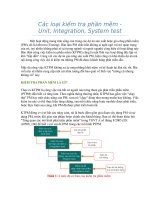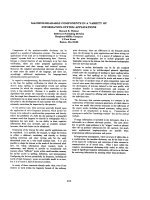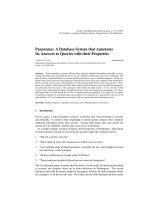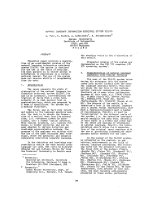Integration & System Testing potx
Bạn đang xem bản rút gọn của tài liệu. Xem và tải ngay bản đầy đủ của tài liệu tại đây (1.01 MB, 92 trang )
Integration & System
Testing
2
Contents
Levels of Testing
Integration Testing
System Testing
Additional System Test Categories
3
Levels of Testing
4
Levels of Testing
Waterfall model
Requirements
Specification
Preliminary
Design
Detailed
Design
Coding
Unit
Testing
Integration
Testing
System
Testing
5
Levels of Testing
Unit testing
Integration Testing
System Testing
Acceptance Testing
Regression Testing
6
Unit testing
Lowest Level of Testing
Individual unit of the software is tested in
isolation from other parts of a program
What can be a unit?
Function / method / module / class / component
Screen / Program
Back-end related to a Screen
Screen + back end
7
Unit testing
Uncover errors in design and implementation,
including
data structure in a unit
program logic and program structure in a unit
unit interface
functions and operations of a unit
Unit testers
developers of the units
8
Integration Testing
Intermediate level of testing
Group of dependent components are tested together
Test that evaluates the interaction and consistency of interacting
components
Uncover errors in:
Design and construction of software architecture
Integrated functions or operations at sub-system level
Interfaces and interactions between them
Resource integration and/or environment integration
Integration testers
either developers and/or test engineers
9
System Testing
Test the whole system
Test end to end functionality
Testing against complete requirement
Requirement focus
Test cases derived from specification
System testers
test engineers
10
Acceptance Testing
User (or customer) involved
Environment as close to field use as possible
Focus on:
Building confidence
Compliance with defined acceptance criteria in
the contract
11
Regression Testing
Testing activities occur after software changes
Regression testing usually refers to testing activities
during software maintenance phase
Retest changed components (or parts)
Check the affected parts (or components)
Who perform regression testing
Developers - regression testing at the unit level or integration
Test engineers - regression testing at the function level
QA and test engineers - regression testing at the system level
12
Example: SATM
Simple Automatic Teller Machine (SATM)
reduced commercial ATM system
hundreds of screens
Has 15 screens
Used to illustrate some testing approaches
Integartion testing, system testing
13
Example: SATM
Decomposed by screens
screen1 welcome
screen2 enter PIN
screen3 wrong PIN
screen4 PIN failed, card retained
screen5 select trans type
screen6 select account type
screen7 enter amount
screen8 insufficient funds
screen9 cannot dispense that amount
screen10 cannot process withdrawals
screen11 take your cash
screen12 cannot process deposits
screen13 put dep envelop in slot
screen14 another transaction?
screen15 Thanks; take card and receipt
14
Example: SATM
15
Example: SATM
Functional
decomposition
16
Example: SATM
17
Example: SATM
18
Integration Testing
19
Goals of Integration Testing
Presumes previously tested units
Not system testing (at level of system inputs
and outputs)
Tests functionality "between" unit and system
levels
Simulation of other components/units
Stubs receive output from test objects
Drivers generate input to test objects
20
Approaches to Integration
Testing
Based on Functional Decomposition
Big Bang
Top-Down
Bottom-Up
Sandwich
Based on Call Graph
Pair-wise integration
Neighborhood integration
Based on Paths
MM-Paths
Atomic System Functions
21
Integration Testing Based on
Functional Decomposition
SATM Functional Decomposition Tree
22
Approaches to Integration
Testing
Based on Functional Decomposition
Big Bang
Top-Down
Bottom-Up
Sandwich
Based on Call Graph
Pair-wise integration
Neighborhood integration
Based on Paths
MM-Paths
Atomic System Functions
23
Big bang Integration
Combine (or integrate) all parts at once
Advantages
simple
Disadvantages
hard to debugging, not easy to isolate errors
not easy to validate test results
impossible to form an integrated system
24
Top-down integration
Begins with the main program (the root of the tree)
Needs the stubs
receive output from test objects
Testers have to develop the stubs
Stub example
returns a PIN instead of looking-up in a table
Procedure GetPINforPAN (PAN, ExpectedPIN) STUB
IF PAN = '1123' THEN PIN := '8876';
IF PAN = '1234' THEN PIN := '8765';
IF PAN = '8746' THEN PIN := '1253';
End,
25
Top-down integration
Integration process
1. The main control module is used as a test driver, and the stub
are substituted for all modules directly subordinate to the main
control module
2. Subordinate stubs are replaced one at a time with actual
modules
3. Tests are conducted as each module is integrated
4. On completion of each set of tests, another stub is replaced with
the real module
5. Regression testing may conducted
Pros and cons top-down integration
stub construction cost
major control function can be tested early









